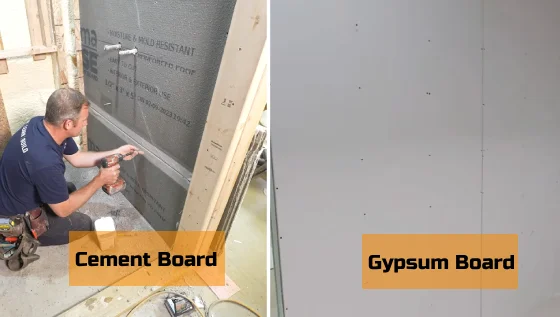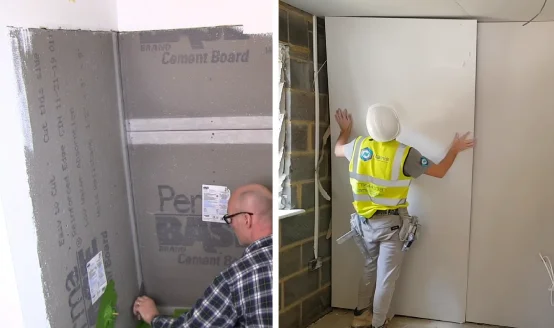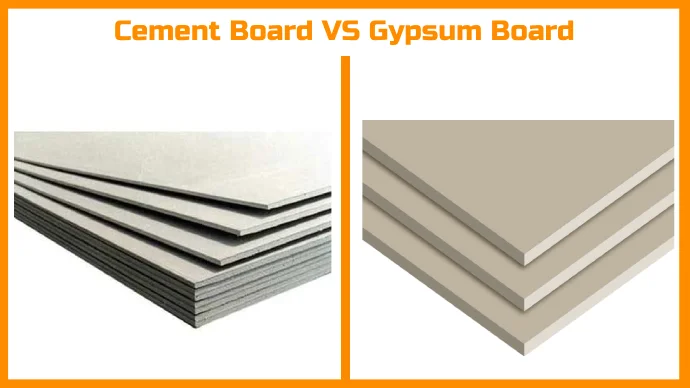Last Updated on September 13, 2023
Wall and ceiling construction projects require careful consideration between two popular options: cement board and gypsum board.
The cement board is made from cement and reinforced with fiberglass mesh. It’s incredibly durable and moisture-resistant, ideal for high-moisture areas like bathrooms or kitchens.
Conversely, a gypsum board (also known as drywall) is made from gypsum plaster sandwiched between two sheets of paper. It’s less strong than cement board, but it’s easier to work with, making it a popular option for interior walls and ceilings.
Understanding the key differences between these two types of boards can help you decide which one is better suited for your needs.
Cement Board vs Gypsum Board: Key Differences

Cement boards and gypsum boards are two types of construction materials used in building and remodeling projects. While they may appear similar at first glance, several key differences exist between the cement and gypsum boards. Here are the main differentiating factors:
#1: Composition and Materials
You’ll notice that cement and gypsum boards have very different compositions and materials.
Cement board is made primarily of cement and reinforcing fibers such as fiberglass or cellulose. Its durable and rigid composition provides excellent moisture, fire, and impact resistance.
On the other hand, a gypsum board comprises gypsum plaster sandwiched between two layers of paper. Its lightweight nature makes it relatively easy to work with but less resistant to moisture and impact compared to cement board.
These differences in composition directly affect the strength and durability of both types of boards. And since cement board has superior strength and resistance, it is often the preferred choice for applications that require extra protection.
#2: Strength and Durability
One type of board is exceptionally strong and durable, while the other is more susceptible to moisture, impact, and fire damage. Cement boards can withstand heavy loads and are often used in areas prone to high humidity or requiring increased durability.
Conversely, gypsum boards are less strong or durable but can handle regular wear and tear. Cement board’s strength also allows for its use in commercial settings like restaurants, grocery stores, and hotels.
#3: Moisture Resistance
When you step into your steamy bathroom after a long day, you want to ensure the walls and ceiling can handle the moisture without warping. This is where the cement board shines. It offers superior moisture resistance compared to gypsum boards.
Cement board doesn’t swell or degrade when damp, making it an excellent choice for areas prone to moisture, like bathrooms, showers, and basements. It can also use line tiled walls and floors without the risk of water damage.
Alternatively, gypsum boards can absorb water and become damaged if exposed to excessive moisture or prolonged water contact. For this reason, cement boards can withstand high humidity levels and damp conditions without deteriorating over time.
#4: Fire Resistance
If a fire were to occur, you’d want a material that could withstand high temperatures without releasing toxic gasses or contributing to the spread of flames. That’s where cement board excels.
Its non-combustible nature and excellent fire resistance properties make it an ideal choice for fire-rated assemblies and areas where fire protection is essential. And unlike gypsum boards, cement boards won’t sag or melt if exposed to flames.
Meanwhile, gypsum board offers good fire resistance but cannot match the inherent fireproof qualities of cement board. Although it has a layer of naturally fire-resistant gypsum, its paper coverings on both sides can burn and contribute to the spread of flames.
Therefore, if you’re looking for maximum safety in case of a fire outbreak, go for a cement board over a gypsum board. For example, installing cement boards behind a stove or in a fireplace area can provide an additional layer of protection and peace of mind.
#5: Installation
To ensure moisture and fire resistance, it is crucial to install the chosen material correctly. When it comes to installation, cement boards pose a greater challenge due to their heavier weight and rigidity.
Special cutting tools and fasteners designed for cementitious materials are often required. For optimal performance in wet areas, sealants for waterproofing treatments are recommended.
As for the gypsum board, it is relatively lightweight and easy to handle and install. It is easy to cut with a utility knife and attached to framing with screws or nails. Nevertheless, gypsum board installations typically require joint compound, tape for finishing, primer, and paint applications.
Ultimately, proper installation techniques are essential regardless of which type of board you choose to use in your project. And if you are unfamiliar with installing either the cement board or gypsum board, it is wise to consult an expert.
Comparison Table between Cement Board and Gypsum Board
| Aspect | Cement Board | Cement Board |
| Composition | Cement and fiber reinforcement | Gypsum plaster with paper coverings |
| Strength and Durability | Very strong and durable | Less strong and durable |
| Moisture Resistance | Excellent resistance to moisture | Susceptible to damage from moisture |
| Fire Resistance | Excellent fire resistance | Good fire resistance with limitations |
| Common Applications | Bathrooms, kitchens, exterior walls | Interior walls and ceilings |
| Weight | Heavier | Lighter |
| Installation | Requires special tools and techniques | Relatively easy to handle and install |
| Cost | Usually more expensive | Typically less expensive |
Make the Right Choice: Cement Board or Gypsum Board for Your Construction Project

Selecting a board for your construction project depends on your specific needs and requirements. Cement board is an ideal choice for moisture-prone areas, such as bathrooms and kitchens due to its resistance to mold and durability.
But the gypsum board is a versatile option that works in various applications and is easier to install. Nonetheless, it’s not recommended for areas exposed to high moisture levels.
It’s also crucial to consider the factors discussed in this article before deciding. Take into account the type and location of the project, and ensure that you follow the proper installation guidelines for the board you choose.
Remember, selecting the correct board is crucial to ensure the longevity and safety of your construction project. Don’t hesitate to consult with experienced professionals if needed.



